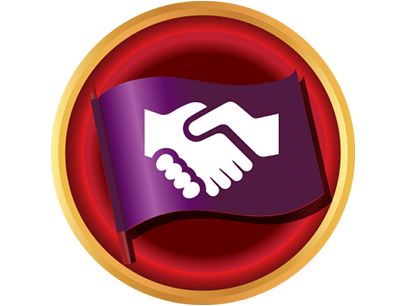
Bringing a group together might seem easy. But motivating individuals to work cohesively to achieve a goal requires a special set of skills. The art of motivation is just that: a masterful blend of communication expertise, motivational techniques and leadership abilities. If you want to become a more adept motivator, consider the Motivational Strategies path.
Like the other paths in the Pathways learning experience, Motivational Strategies challenges you to grow by moving through five levels of increasingly complex projects. Some are required, some are electives. You build a solid foundation of speechwriting and evaluation best practices at Level 1, then begin completing more motivation-focused projects at Level 2.
Participants do more than read about motivational techniques; they apply them as part of their assignments. By gaining firsthand experience along the way, members strengthen their communication and leadership skills in this area by the time they complete the fifth and final level of the path.
Adrian Jefferson Chofor, a member of the Oakland Uptown Toastmasters in Oakland, California, has completed Motivational Strategies. She says its lessons are particularly applicable to her many roles: She is a marketing operations consultant for the Kaiser Permanente health care network and a personal-transformation specialist empowering women. Plus, she was a 2018–2019 Toastmasters area director.
The projects in this path are highly relevant in today’s world, notes Jefferson Chofor. “We have to motivate people all the time. We have to negotiate, influence or persuade people to get the things we want or to help people understand our way of thinking,” she says.
Learning About You
Before you can motivate, you need to discover how you communicate with others. That’s where Level 2 comes in. You spend time learning about you.
Like Jefferson Chofor, you may be surprised at what you learn in “Understanding Your Communication Style.” This project is all about identifying your styles of communication and how to leverage and improve them.
“I thought I was more collaborative,” says Jefferson Chofor. “But apparently I’m a take-charge kind of person.”
Are you supportive or direct? Maybe you’re more initiating, or even analytical. The project includes a questionnaire to help pinpoint your strengths, as well as the styles you’re less keen on. More than that, you’ll determine how to improve your relationships by mastering and adapting your styles to a specific person, group or situation.
The “Active Listening” project also helps participants learn more about themselves. That’s because listening is more than just processing someone else’s words—it’s understanding and repeating what you hear. The assignment requires members to serve as Topicsmaster at a meeting and make meaningful comments about each impromptu speech. Before that, they learn that active listening involves focusing on body language, verbal cues and nonverbal cues. And that listening, really listening, helps build more meaningful relationships.
More About Human Nature
Level 3 features another deep dive into how people operate. For the project “Understanding Emotional Intelligence,” participants spend two weeks keeping a journal about their emotions and the effect they have on themselves and others. Participants learn how to assess their emotions honestly, monitor them and express them appropriately (for example, when responding to people in difficult situations). They also practice techniques to improve empathy.
Jefferson Chofor says emotional intelligence is one of the most valuable skills she developed on the path. The benefits of the journaling component, which strengthens self-awareness, are ongoing for her and the clients she coaches.
“My job as a coach is to help women accept their true selves and step forward confidently in revealing their true personality,” she says.
What does emotional intelligence have to do with motivation? A lot. By being more self-aware and able to self-regulate your emotional responses to other people, you become equipped to make stronger connections. Strong connection is vital to motivation.
So is having an optimistic attitude about life and an awareness of intrinsic versus external motivation, which is detailed in the project. The topic resonated with Michael Cannon, who is close to completing the path. A member of the HCA Artful Articulators, a corporate club in Nashville, Tennessee, Cannon says he learned a great deal about motivation serving in the military. He originally assumed that those in military service were motivated mainly by goals imposed by their leaders.
“I thought I was more collaborative. But apparently I’m a take-charge kind of person.”
— ADRIAN JEFFERSON CHOFOR“After a few years in, I realized the truth was actually the inverse of this assumption. The most effective military leaders are those who push individuals to motivate themselves,” says Cannon, a Toastmaster for nine years. “I have seen that idea play out in the business world as well. I am not strong at building relationships and learning what would best motivate my peers. I chose this path in order to learn something completely new and develop a skill I do not have.”
To learn more about emotional intelligence, read this month's cover story.
Motivating Through Leadership
In Motivational Strategies, members apply their skills to real-world events. In the Level 4 project “Motivate Others,” they build and lead a team to complete a project that benefits their club. The assignment teaches the different aspects of motivational techniques. For example, when you lead a team, it is important to first acquaint yourself with each team member to form connections and determine what each person needs to feel motivated.
While Jefferson Chofor completed the path last year, she says she continues to use the motivation skills she learned. She is currently helping to charter a new corporate club. “I may not be the leader of this new club, but I can offer guidance and influence and coaching.”
The “Motivate Others” project includes an evaluation questionnaire that can be sent to team members to determine your successes as a leader and where you have room to grow. Accepting constructive feedback is important to build positive relationships and improve interpersonal communication.
Level 5 is about demonstrating the expertise you develop along the path. That’s why in the “Team Building” project, you are tasked with building a team, planning and organizing a team-building event and then hosting the activity. The competencies in this project are a culmination of everything you learn in previous levels: building an open and supportive environment, communicating effectively, adapting to your team and knowing which motivational techniques will produce a stronger group. You give two speeches to your club: one before the event and another after.
Cannon, the member from Tennessee, says forming a team and collaborating on producing an event was a real stretch, which made the team-building project the most beneficial one in the path to him. “Building relationships is a large area of personal weakness, so the project has pushed me to be uncomfortable and take responsibility for a team-building and relational growth,” he says.
As she prepared for her term as club president to end and her role as a district officer to begin, Jefferson Chofor organized team-building events as well as leadership and communication seminars to ensure the future success of her club.
“I wanted to motivate people to step up into leadership roles and understand the skills they receive in Toastmasters are transferrable to their jobs or even their personal lives.”
For more information about the Motivational Strategies path, visit the Pathways webpage. The website also provides an overview of the Pathways program, with history, videos and answers to frequently asked questions.
Shaelyn Berg worked on the Pathways development team at Toastmasters World Headquarters and is now a freelance writer and editor.
Related Articles

Club Experience
The Path to Strategic Relationships

Toastmasters News



 Previous
Previous
 Fast Facts on this Path
Fast Facts on this Path
 Previous Article
Previous Article